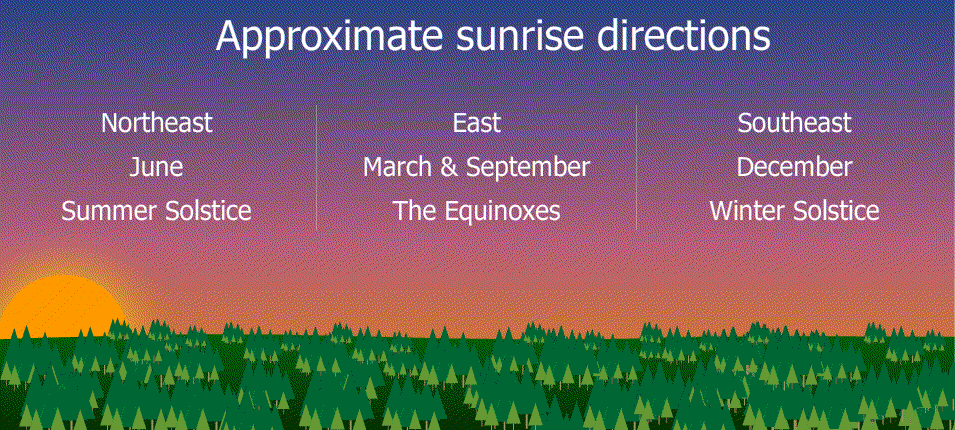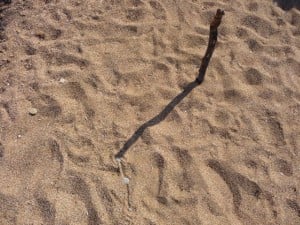People have been finding their way by using the stars for centuries, that’s nothing new. What you may not be familiar with is knowing how to find your way using the sun.
Now before you go and say “the sun rises in the East, and sets in the West” you’d be right, and wrong. There’s more to it than that.

In this post you will learn how to accurately find your way using the sun as your compass.
Learning to find your way by using the sun is best accomplished by beginning at the start of the day.
One of the simplest questions in natural navigation is: ‘What direction does the sun rise?’ The answer most people confidently give is, ‘East!’, but bizarrely this answer is both right and wrong at the same time. Understanding why is one of the keys to using the sun to find your way at the start and end of the day.
The sun rises due east on only two days of the year, the equinoxes, near March 21 and September 22 each year. Every other day of the year it rises somewhere else. But where and why?

The answers lie in the tilt of the Earth as it moves around the sun. On midsummer’s day in the northern hemisphere, around June 21st each year (the summer solstice), the North Pole is tilted as much as it ever will be towards the sun.
This is why it is summer in the northern hemisphere and winter in the southern. On midwinter’s day, around December 22 each year (the winter solstice), the South Pole is tilted as much as possible towards the sun.
This means that in the middle of a UK summer, when the North Pole is tilted towards the sun, the sun will rise north of east, and we are not talking about a couple of degrees. It will be close to northeast in Britain in late June. Similarly in late December it will rise much closer to southeast than east. The difference between sunrise directions in midsummer and midwinter is a whopping 90 degrees!
When it comes to sunset, the Poles are still tilted the same way as in the morning and so in midsummer the sun sets close to northwest, and in midwinter it sets close to southwest.
The exact bearing of sunrise and sunset is determined by your latitude and the time of year. The greater your latitude and the closer you are to one of the solstices, the further from east and west the sun rises and sets.
If you take it to the extreme, then in the Arctic Circle in June the sun rises so far north of east and sets so far north of west that these points actually overlap – in other words the sun doesn’t set.

If you walk in the direction of sunrise in March or September and then turn around at the end of the day and head back towards sunset you stand a good chance of finding your way back to where you set out from (out east, back west).
If you try the same thing in midsummer or midwinter you will get horribly lost. If you walk towards sunrise in midwinter you would need to walk with the sunset over your left shoulder to get back to the same spot at the end of the day (out southeast, back northwest).
The trick for avoiding confusion and keeping it as simple as possible is to think about the season and then use that to work out which pole is pointing towards the sun. Whichever pole, north or south, is pointed towards the sun will give the answer to which side of east and west that the sun will rise and set that day – anywhere in the world.

The Next Step
The next stage in using the sun to find your way is being confident which direction the sun will be at midday. The shortest shadow cast by a stick each day will form a perfect north-south line anywhere in the world and this happens at midday. By marking the end of a stick’s shadow tips over the course of the middle part of the day and joining them, a curve is made. The closest point on this curve to the stick will be a perfect north/south line.
For natural navigation purposes midday is the moment that the sun is highest in the sky, not what your watch says. This is important because this is the moment that the sun has stopped rising, ie. it is no longer east of you, and before it starts setting and heads west of you. Anywhere in the world that is north of the Tropic of Cancer, and that includes all of Europe and the US, the sun will be due south at midday. The tip of the shortest shadow cast by a stick during the course of a day, or any other object like a tree, will point north in the UK, the base of the stick will point south.

Using a shadow stick to find direction
The next step in finding direction naturally using the sun is bringing the pieces together and then practicing the art of interpolation, that is estimating what direction the sun will be between two known points. This is an art that all desert nomads and wilderness explorers have honed over their lifetimes. Let’s look at some examples. What direction will the sun be in the middle of the morning in the UK in March?
March is the month of an equinox and the sun will rise very close to due east and set close to due west everywhere in the world. It will be due south at midday in the UK, as the UK is north of the Tropic of Cancer. The middle of the morning is halfway from morning to midday and so the sun will have moved approximately halfway from east to south. The sun will be close to southeast.
What about mid-afternoon in December? The sun passes through south at midday and then sets in the southwest in the UK in December and so the sun will be close to south-southwest in the middle of the afternoon. One hour after sunrise in May? It is close to June and the sun will rise close to northeast, after one hour it will have moved a little towards south, but not much – east-northeast would be a fair estimate.
With practice this method can be used anywhere in the world, although it is not very practical in the tropics near the middle of the day as the sun is too high. It can be refined by coming to know the science and maths of the angles better or through hundreds of hours of practice, as ancient and modern land and sea navigators have learned to do since man’s first serious journeys.
Exact sunrise direction depends on time of year and your latitude. The further from the equator you are, the further from East and West the sun will rise and set in June and December.

No comments:
Post a Comment
Note: Only a member of this blog may post a comment.